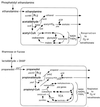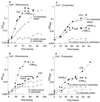The alternative electron acceptor tetrathionate supports B12-dependent anaerobic growth of Salmonella enterica serovar typhimurium on ethanolamine or 1,2-propanediol
- PMID: 11274105
- PMCID: PMC95162
- DOI: 10.1128/JB.183.8.2463-2475.2001
The alternative electron acceptor tetrathionate supports B12-dependent anaerobic growth of Salmonella enterica serovar typhimurium on ethanolamine or 1,2-propanediol
Abstract
Synthesis of cobalamin de novo by Salmonella enterica serovar Typhimurium strain LT2 and the absence of this ability in Escherichia coli present several problems. This large synthetic pathway is shared by virtually all salmonellae and must be maintained by selection, yet no conditions are known under which growth depends on endogenous B12. The cofactor is required for degradation of 1,2-propanediol and ethanolamine. However, cofactor synthesis occurs only anaerobically, and neither of these carbon sources supports anaerobic growth with any of the alternative electron acceptors tested thus far. This paradox is resolved by the electron acceptor tetrathionate, which allows Salmonella to grow anaerobically on ethanolamine or 1,2-propanediol by using endogenously synthesized B12. Tetrathionate provides the only known conditions under which simple cob mutants (unable to make B12) show a growth defect. Genes involved in this metabolism include the ttr operon, which encodes tetrathionate reductase. This operon is globally regulated by OxrA (Fnr) and induced anaerobically by a two-component system in response to tetrathionate. Salmonella reduces tetrathionate to thiosulfate, which it can further reduce to H2S, by using enzymes encoded by the genes phs and asr. The genes for 1,2-propanediol degradation (pdu) and B12 synthesis (cob), along with the genes for sulfur reduction (ttr, phs, and asr), constitute more than 1% of the Salmonella genome and are all absent from E. coli. In diverging from E. coli, Salmonella acquired some of these genes unilaterally and maintained others that are ancestral but have been lost from the E. coli lineage.
Figures








Similar articles
-
Two global regulatory systems (Crp and Arc) control the cobalamin/propanediol regulon of Salmonella typhimurium.J Bacteriol. 1993 Nov;175(22):7200-8. doi: 10.1128/jb.175.22.7200-7208.1993. J Bacteriol. 1993. PMID: 8226666 Free PMC article.
-
Evidence that a B12-adenosyl transferase is encoded within the ethanolamine operon of Salmonella enterica.J Bacteriol. 2004 Nov;186(22):7635-44. doi: 10.1128/JB.186.22.7635-7644.2004. J Bacteriol. 2004. PMID: 15516577 Free PMC article.
-
Glutathione is required for maximal transcription of the cobalamin biosynthetic and 1,2-propanediol utilization (cob/pdu) regulon and for the catabolism of ethanolamine, 1,2-propanediol, and propionate in Salmonella typhimurium LT2.J Bacteriol. 1995 Oct;177(19):5434-9. doi: 10.1128/jb.177.19.5434-5439.1995. J Bacteriol. 1995. PMID: 7559326 Free PMC article.
-
Cobalamin (coenzyme B12): synthesis and biological significance.Annu Rev Microbiol. 1996;50:137-81. doi: 10.1146/annurev.micro.50.1.137. Annu Rev Microbiol. 1996. PMID: 8905078 Review.
-
Multiple biosynthetic pathways for vitamin B12: variations on a central theme.Vitam Horm. 2001;61:267-97. doi: 10.1016/s0083-6729(01)61009-4. Vitam Horm. 2001. PMID: 11153269 Review.
Cited by
-
Bacterial iron-sulfur cluster sensors in mammalian pathogens.Metallomics. 2015 Jun;7(6):943-56. doi: 10.1039/c5mt00012b. Metallomics. 2015. PMID: 25738802 Free PMC article. Review.
-
The salmonella transcriptome in lettuce and cilantro soft rot reveals a niche overlap with the animal host intestine.Appl Environ Microbiol. 2013 Jan;79(1):250-62. doi: 10.1128/AEM.02290-12. Epub 2012 Oct 26. Appl Environ Microbiol. 2013. PMID: 23104408 Free PMC article.
-
Fructose-asparagine is a primary nutrient during growth of Salmonella in the inflamed intestine.PLoS Pathog. 2014 Jun 26;10(6):e1004209. doi: 10.1371/journal.ppat.1004209. eCollection 2014 Jun. PLoS Pathog. 2014. PMID: 24967579 Free PMC article.
-
Genetically engineered bacteria as inflammatory bowel disease therapeutics.Eng Microbiol. 2024 Sep 1;4(4):100167. doi: 10.1016/j.engmic.2024.100167. eCollection 2024 Dec. Eng Microbiol. 2024. PMID: 39628589 Free PMC article. Review.
-
The Crystal Structure of the C-Terminal Domain of the Salmonella enterica PduO Protein: An Old Fold with a New Heme-Binding Mode.Front Microbiol. 2016 Jun 28;7:1010. doi: 10.3389/fmicb.2016.01010. eCollection 2016. Front Microbiol. 2016. PMID: 27446048 Free PMC article.
References
-
- Bobik T, Havemann G, Busch R, Williams D, Aldrich H. The propanediol utilization (pdu) operon of Salmonella enterica serovar Typhimurium LT2 includes genes necessary for formation of polyhedral organelles involved in coenzyme B12-dependent 1,2-propanediol degradation. J Bacteriol. 1999;181:5967–5975. - PMC - PubMed
Publication types
MeSH terms
Substances
Associated data
- Actions
Grants and funding
LinkOut - more resources
Full Text Sources
Other Literature Sources
Molecular Biology Databases
Research Materials
Miscellaneous

